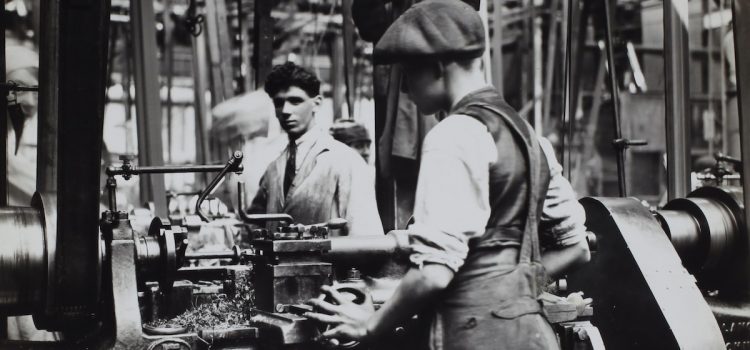

This article is an excerpt from the Shortform book guide to "Do Nothing" by Celeste Headlee. Shortform has the world's best summaries and analyses of books you should be reading.
Like this article? Sign up for a free trial here.
How did the Industrial Revolution change the way people work? In what ways are we still feeling the effects?
In today’s fast-paced world, our lives increasingly revolve around productivity, efficiency, and work. In her book Do Nothing, Celeste Headlee writes that our culture of overworking can be traced back to the Industrial Revolution.
Continue reading to learn how the nature of work in the Industrial Revolution shaped the modern lifestyle.
The Historical Origins of Overworking
The Industrial Revolution was a period of rapid technological advancement in Europe and the US beginning in the 1700s. During the Industrial Revolution, inventions such as the steam engine drastically changed the way people lived and worked due to the proliferation of factories, which quickly became a common place of employment. During this period, many people migrated to cities for work.
Headlee identifies two specific factors that encouraged people to prioritize work in the Industrial Revolution: 1) the economic pressure to work more due to the rise of wage labor and 2) the cultural pressure to work hard, which stemmed from Protestantism and the American dream narrative. Together, Headlee argues, these economic and cultural factors spurred people to work more hours than humans had ever done historically. In this section, we’ll break down each of these factors and how they played a part in the work culture we inherited today.
| Do Headlee’s Arguments Apply Globally? Throughout the book, Headlee implies that overworking is a global cultural problem. However, much of her research is based on American and European history as well as her experience as an American, so it’s important to distinguish which of her arguments apply globally and which of them apply more specifically to the US or Western cultures. In terms of the impact of the Industrial Revolution, these economic changes were a global phenomenon. The Industrial Revolution began in England during the 1700s and spread as the technologies reached the US and other regions over the next 300 years. This period is known broadly as a period of industrialization when countries shifted away from agriculture and toward manufacturing as the basis for their economy. For example, China and India both experienced an increase in industrialization beginning in the mid-20th century. Therefore, while the shifts that Headlee describes happened at different times in various parts of the world, the larger trends apply globally. And, what about the idea that people around the world are overworking themselves in the modern age? International research suggests that people in many regions of the world are suffering from worse health outcomes because of overwork. One study by the World Health Organization found that people have the highest risk of health problems from overwork in Southeast Asia and the Western Pacific, while people in Europe had the lowest risk. On the other hand, some of Headlee’s explanations for the driving factors of overworking—such as the American dream narrative—are specific to the US. In other places, work cultures might be influenced by other country-specific factors such as legal limits on weekly work hours. |
Economic Pressure: Wage Labor During the Industrial Revolution
Headlee explains that before the Industrial Revolution, more people had access to land that they could live off of, and many people worked in trades such as carpentry. However, during the Industrial Revolution, those options dwindled as a small upper-class consolidated land ownership. This reduced other people’s access to land, and factories cheaply mass-produced products, making it increasingly difficult for artisans to sell handmade products.
Headlee posits that, as more people were forced to move from rural areas to cities to find work, the economic autonomy of the working class declined sharply, and people had to work longer hours to meet their basic needs. For example, instead of working on chores that were done as needed, like taking care of livestock and gardens, people had to trade their time for money and had little control over their working conditions, wages, and schedules. Workers had to meet the demands of their employers, often in unpleasant factory environments, or risk losing their jobs and livelihoods.
| What Caused Land Loss and the Rural Exodus? Two main factors contributed to these conditions and the decline in worker autonomy during the Industrial Revolution: the Enclosure Movement in Europe and the rise of industrial farming. During the Enclosure Movement, state governments in Europe converted land that was traditionally used communally (commons) into private property and sold it to the aristocracy to manage and profit from commercial production. This drastically reduced the amount of land that rural communities could steward, leading to increased migration to cities. In addition, vast tracts of farmland in Europe were consolidated as innovations in commercial-scale agriculture decreased people’s ability to make a living from small-scale subsistence farming. Similar to the way manufacturing technology made it more difficult to make a living as an artisan, farmers no longer had the resources and land to compete with industrial farms. For example, the seed drill automated the process of planting crops, making it much more cost-effective for commercial farms that could buy large tracts of land and invest in expensive, more efficient equipment. |
Headlee writes that, during this time, people started working 10 to 14 hours per day on monotonous tasks. By contrast, medieval peasants worked a maximum of eight hours per day and took about a third of the year off. This example and other historical reference points reinforce the idea that industrialization significantly increased the number of work hours required to survive.
(Shortform note: Data suggest that working hours started to decrease around 1870 when people worked about 60 to 70 hours per week for 50 weeks per year. Today, people in wealthier countries work about half as much, although there are large disparities by country in terms of working hours. For example, the US averages 34 hours per week while Colombia and Turkey both average 48 hours per week. Economic data suggest that greater wealth and higher wages in a country both decrease the number of hours people work.)
Power Struggle Between Laborers and the Economic Elite
In contrast to the loss of autonomy for working-class laborers, the wealthy business-owning class benefited from cheap labor and the massive profits from selling retail products like clothing and household goods. As a result, they leveraged their power to exploit laborers by forcing people to work long hours for as little pay as possible.
(Shortform note: Many people disagree about the net impact of wage labor and the power dynamic between employers and laborers. In The Communist Manifesto, Karl Marx argues that this dynamic is part of what makes the capitalist economic system unjust: Business and the accumulation of wealth rely on the upper class taking advantage of laborers and treating them like commodities. On the other hand, others argue that capitalist-driven entrepreneurialism led to more affordable products that increased people’s overall quality of life, including that of laborers.)
Headlee says that, around the turn of the 20th century, labor unions started forming to curb employers’ power and implement policies like the eight-hour workday. Despite the fact that police and the military often responded to strikes with violence, people in the US, Europe, and other regions fought for improvements to working conditions and limited work hours.
Headlee explains that, when faced with these limitations (around the turn of the 20th century), the wealthy class then shifted their attention to new strategies to encourage people to work more. Some of these were internal, company-level strategies like dangling promotions to encourage workers to compete with one another by working harder. The wealthy class implemented other methods to change how people thought about work in general.
| The Great Depression Made Work More Scarce and Valuable In Your Money or Your Life, Vicki Robin and Joe Dominguez highlight another historic turning point in work culture that Headlee doesn’t discuss: the Great Depression. During this severe economic recession in the US, beginning in 1929, the lack of work opportunities and people’s dire financial needs encouraged the working class to value work more highly and shifted the power dynamic in favor of employers. Robin and Dominguez assert that because of continued high unemployment throughout the 1930s, people started to value work more than they valued leisure, thus reversing the trend of the labor movement to reduce working hours. Workers still needed to work long hours to make enough money to survive, except now they had fewer opportunities to do so, so the scarcity of employment made it more valuable. Since most people still had to work for an employer to make a living and the higher demand for jobs pushed wages down, workers arguably had even less autonomy and bargaining leverage in the workplace than before. These competitive labor market conditions likely reduced the need for employers to actively persuade people to work more. |

———End of Preview———
Like what you just read? Read the rest of the world's best book summary and analysis of Celeste Headlee's "Do Nothing" at Shortform.
Here's what you'll find in our full Do Nothing summary:
- How our fast-paced world is causing us to work less efficiently
- How the culture of overworking has led to social isolation and poor health
- How to embrace true leisure to live a happier and healthier life






